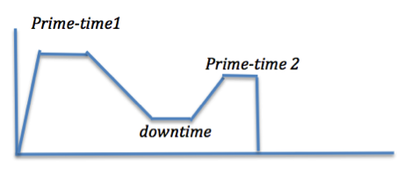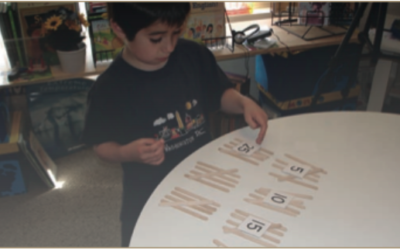Short-term memory includes both immediate and working memory, each with very restrictive time and capacity limits (Sousa, 2008). The hippocampus uses “sensory input from the thalamus, movement coordination in the basal ganglion and emotions in the hypothalamus to form short-term memory. Communication between hippocampus and the brain area that handles sensory information fortifies our memories” (Hannaford, 1995, p.60).
During a lesson, we tend to remember best which comes first and second best that which comes last (Sousa, 2008). This is known as the serial position effect. The reason this happens is that the information in the first few minutes is within the working memory’s capacity limits, but later during the lesson, our capacity limits have been exceeded. The following diagram by Sousa, 2006, illustrates what this might look like in a 40 minute lesson. The retention time periods are labeled as prime-time-1 and prime-time-2.

0 10 20 30 40
The degree of retention during a learning episode (Sousa 2008, p. 61)
There are two kinds of long-term memories, declarative and non-declarative (Sousa, 2008), which are stored in different parts of our brains.
Declarative memories include episodic and semantic memories. Episodic memories are when we can remember vividly where we were and what we were doing when an event occurred, like the fall of the Berlin Wall. Semantic memories, on the other hand, are how we remember the meanings of words and other factual and general information of our environment. These memories are stored in the hippocampal region, entorhinal cortex, perirhinal cortex, and parahippocampal cortex (Ullman, 2005).
Non-declarative memories are those that are more emotional, automatic, and procedural. The ability to ride a bike is considered a procedural memory. We would have a hard time explaining exactly how to do it, our bodies just know. These skills are shifted from a reflective to a reflexive thought process after they are mastered (Sousa, 2008).
The parts of the brain that are dedicated to non-declarative memories are the frontal and basal-ganglia circuits; the parietal cortex for working memory tasks and knowledge of motor skills; the cerebellum where memory of balance, skilled movement and motor sequencing is stored; and the Broca’s area which stores the process of non-motor sequences like music, timing, and rhythm (Ullman, 2005).
When examining the idea of neuroplasticity and how the brain can change, we saw that repetition, or rehearsal, is an important element of that change. This is especially true for moving information from our short-term to long-term memory. There is a definite chemical reaction in the brain when information goes from short to long-term memory. A protein, kinase A, “moves from the body of the neuron into its nucleus, where genes are stored. The protein turns on a gene to make a protein that alters the structure of the nerve ending, so that it grows new connections between the neurons” (Doidge, 2007, p. 220). What this means is that when we learn, we are actually changing which genes are turned on.
Sousa describes different types of rehearsal: intial and secondary, which involve when the rehearsal takes place; and rote and elaborative, which is the type of rehearsing being done.
Initial rehearsal occurs immediately when the student is presented with the information and tries to attach meaning to it. If he is unsuccessful at this moment, then the new information will most likely not be retained.
Secondary rehearsal allows students to spend more time to make sense of the material and connect the ideas to previous knowledge, which increases the chance of retention (Sousa, 2008).
When you practice something, it gets easier for the signals to cross the synapse. That’s because the contact area becomes wider and more neuro- transmitters are stored there.
Rote rehearsal is used when trying to memorize, for instance the multiplication tables or other math facts, but elaborative rehearsal is used to associate and connect the new information to prior knowledge and looking for relationships and patterns.
This is from my book, Movement Makes Math Meaningful: Away from the Desk Math Lessons Aligned with the Common core





0 Comments